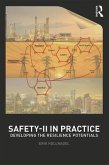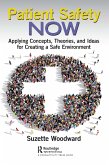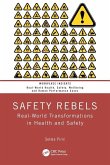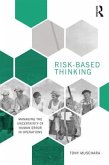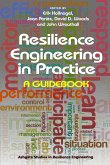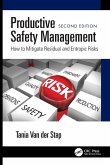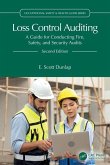Navigating the FRAM
Mastering the Functional Resonance Analysis Method for Modelling Complex Socio-Technical Systems
Herausgeber: Patriarca, Riccardo
Navigating the FRAM
Mastering the Functional Resonance Analysis Method for Modelling Complex Socio-Technical Systems
Herausgeber: Patriarca, Riccardo
- Broschiertes Buch
- Merkliste
- Auf die Merkliste
- Bewerten Bewerten
- Teilen
- Produkt teilen
- Produkterinnerung
- Produkterinnerung
Developed over decades of meticulous research, the FRAM serves as a powerful tool for modeling intricate systems, encompassing various realms: aviation, healthcare, IT software requirements, crisis management, and more. This book represents a culmination of two decades of research and practical applications of the FRAM.
Andere Kunden interessierten sich auch für
![Safety-II in Practice Safety-II in Practice]() Erik HollnagelSafety-II in Practice38,99 €
Erik HollnagelSafety-II in Practice38,99 €![Patient Safety Now Patient Safety Now]() Ralph R.B. Von FresePatient Safety Now55,99 €
Ralph R.B. Von FresePatient Safety Now55,99 €![Safety Rebels Safety Rebels]() Selma PiricSafety Rebels50,99 €
Selma PiricSafety Rebels50,99 €![Risk-Based Thinking Risk-Based Thinking]() Tony MuscharaRisk-Based Thinking62,99 €
Tony MuscharaRisk-Based Thinking62,99 €![Resilience Engineering in Practice Resilience Engineering in Practice]() Jean ParièsResilience Engineering in Practice62,99 €
Jean ParièsResilience Engineering in Practice62,99 €![Productive Safety Management Productive Safety Management]() Tania Van der StapProductive Safety Management51,99 €
Tania Van der StapProductive Safety Management51,99 €![Loss Control Auditing Loss Control Auditing]() E. Scott Dunlap (Eastern Kentucky University, Richmond, USA)Loss Control Auditing69,99 €
E. Scott Dunlap (Eastern Kentucky University, Richmond, USA)Loss Control Auditing69,99 €-
-
-
Developed over decades of meticulous research, the FRAM serves as a powerful tool for modeling intricate systems, encompassing various realms: aviation, healthcare, IT software requirements, crisis management, and more. This book represents a culmination of two decades of research and practical applications of the FRAM.
Produktdetails
- Produktdetails
- Verlag: Taylor & Francis Ltd
- Seitenzahl: 476
- Erscheinungstermin: 14. Oktober 2025
- Englisch
- Abmessung: 234mm x 156mm x 25mm
- Gewicht: 708g
- ISBN-13: 9781032850511
- ISBN-10: 1032850515
- Artikelnr.: 73961624
- Herstellerkennzeichnung
- Libri GmbH
- Europaallee 1
- 36244 Bad Hersfeld
- gpsr@libri.de
- Verlag: Taylor & Francis Ltd
- Seitenzahl: 476
- Erscheinungstermin: 14. Oktober 2025
- Englisch
- Abmessung: 234mm x 156mm x 25mm
- Gewicht: 708g
- ISBN-13: 9781032850511
- ISBN-10: 1032850515
- Artikelnr.: 73961624
- Herstellerkennzeichnung
- Libri GmbH
- Europaallee 1
- 36244 Bad Hersfeld
- gpsr@libri.de
Riccardo Patriarca is an associate professor in the Department of Mechanical and Aerospace Engineering at Sapienza University of Rome, Italy. He holds a BSc in Aerospace Engineering, an MSc in Aeronautical Engineering, and a PhD in Industrial and Management Engineering. He currently teaches Operations Management, Aviation Safety Management, and Human Factors for the MSc courses in Mechanical Engineering and Aeronautical Engineering at Sapienza. His research is oriented towards modelling complex socio-technical systems - including their cyber dimension - untangling their inherent complexities and advancing risk and resilience-aware solutions for an ever-evolving world.
List of Contributors. Foreword. Preface. Acknowledgements. PROLOGUE
Introducing the FRAM. Chapter 1 The FRAM for Socio-Technical Safety
Management and Beyond. Chapter 2 A Brief and Unofficial History of the
FRAM. Chapter 3 The FRAM Essentials: Principles and Building Steps. Chapter
4 The Last Five Years (2019-2024) of FRAM Literature. SECTION I Step 1: To
Identify and Describe the System's Functions. Chapter 5 The Use and
Implications of Small FRAM Models: A Case from Healthcare. Chapter 6
Function Identification and FRAM Modelling of an Aviation Near-Miss Using
Convergent Mixed Methods. Chapter 7 Building a FRAM Model Using Large
Language Models: A Dream or a Nightmare? Chapter 8 A Semantic Lifting of
Language Models to Support FRAM Models Building. SECTION II Step 2: To
Identify the Variability. Chapter 9 Navigation Support from Shore:
Analyzing Remote Pilotage Using the FRAM. Chapter 10 Fuzzy Assessment of
Variability in FRAM Models. Chapter 11 Pathways to Industry 5.0 and Society
5.0: Socio-Technical Systems Modelling through FRAM and Discrete-Event
Simulation. SECTION III Step 3: Aggregate Variability, Actual, and
Potential. Chapter 12 The Milky Way to FRAM: Comparing Instantiations via
Network Metrics in a Dairy Production Plant. Chapter 13 Understanding
Patterns in Mixed Road Traffic: Comparing Functional Critical Paths between
Drivers and Automated Vehicles. Chapter 14 Machine Learning to Support
Human Learning from Variable Performance in FRAM. Chapter 15 The FRAM-IA to
Understand and Assess Distributed Cognition and Control. SECTION IV Step 4:
Assess the Consequences of the Analysis. Chapter 16 Dynamic Variability
Modelling: Capturing Complexities in Variability. Chapter 17 Integrating
the FRAM and Lean for Waste Analysis in Production Systems. Chapter 18
Maximizing the Impact of the FRAM: From Analysis to Implementation.
SECTION V Implementation and Reflections on the FRAM. Chapter 19 FRAM via
Software: The FRAM Model Visualizer. Chapter 20 FRAMing Learning: Learning
about FRAM through Experience. SECTION VI Final Thoughts. Chapter 21 To
FRAM or not to FRAM? Glossary. Index.
Introducing the FRAM. Chapter 1 The FRAM for Socio-Technical Safety
Management and Beyond. Chapter 2 A Brief and Unofficial History of the
FRAM. Chapter 3 The FRAM Essentials: Principles and Building Steps. Chapter
4 The Last Five Years (2019-2024) of FRAM Literature. SECTION I Step 1: To
Identify and Describe the System's Functions. Chapter 5 The Use and
Implications of Small FRAM Models: A Case from Healthcare. Chapter 6
Function Identification and FRAM Modelling of an Aviation Near-Miss Using
Convergent Mixed Methods. Chapter 7 Building a FRAM Model Using Large
Language Models: A Dream or a Nightmare? Chapter 8 A Semantic Lifting of
Language Models to Support FRAM Models Building. SECTION II Step 2: To
Identify the Variability. Chapter 9 Navigation Support from Shore:
Analyzing Remote Pilotage Using the FRAM. Chapter 10 Fuzzy Assessment of
Variability in FRAM Models. Chapter 11 Pathways to Industry 5.0 and Society
5.0: Socio-Technical Systems Modelling through FRAM and Discrete-Event
Simulation. SECTION III Step 3: Aggregate Variability, Actual, and
Potential. Chapter 12 The Milky Way to FRAM: Comparing Instantiations via
Network Metrics in a Dairy Production Plant. Chapter 13 Understanding
Patterns in Mixed Road Traffic: Comparing Functional Critical Paths between
Drivers and Automated Vehicles. Chapter 14 Machine Learning to Support
Human Learning from Variable Performance in FRAM. Chapter 15 The FRAM-IA to
Understand and Assess Distributed Cognition and Control. SECTION IV Step 4:
Assess the Consequences of the Analysis. Chapter 16 Dynamic Variability
Modelling: Capturing Complexities in Variability. Chapter 17 Integrating
the FRAM and Lean for Waste Analysis in Production Systems. Chapter 18
Maximizing the Impact of the FRAM: From Analysis to Implementation.
SECTION V Implementation and Reflections on the FRAM. Chapter 19 FRAM via
Software: The FRAM Model Visualizer. Chapter 20 FRAMing Learning: Learning
about FRAM through Experience. SECTION VI Final Thoughts. Chapter 21 To
FRAM or not to FRAM? Glossary. Index.
List of Contributors. Foreword. Preface. Acknowledgements. PROLOGUE
Introducing the FRAM. Chapter 1 The FRAM for Socio-Technical Safety
Management and Beyond. Chapter 2 A Brief and Unofficial History of the
FRAM. Chapter 3 The FRAM Essentials: Principles and Building Steps. Chapter
4 The Last Five Years (2019-2024) of FRAM Literature. SECTION I Step 1: To
Identify and Describe the System's Functions. Chapter 5 The Use and
Implications of Small FRAM Models: A Case from Healthcare. Chapter 6
Function Identification and FRAM Modelling of an Aviation Near-Miss Using
Convergent Mixed Methods. Chapter 7 Building a FRAM Model Using Large
Language Models: A Dream or a Nightmare? Chapter 8 A Semantic Lifting of
Language Models to Support FRAM Models Building. SECTION II Step 2: To
Identify the Variability. Chapter 9 Navigation Support from Shore:
Analyzing Remote Pilotage Using the FRAM. Chapter 10 Fuzzy Assessment of
Variability in FRAM Models. Chapter 11 Pathways to Industry 5.0 and Society
5.0: Socio-Technical Systems Modelling through FRAM and Discrete-Event
Simulation. SECTION III Step 3: Aggregate Variability, Actual, and
Potential. Chapter 12 The Milky Way to FRAM: Comparing Instantiations via
Network Metrics in a Dairy Production Plant. Chapter 13 Understanding
Patterns in Mixed Road Traffic: Comparing Functional Critical Paths between
Drivers and Automated Vehicles. Chapter 14 Machine Learning to Support
Human Learning from Variable Performance in FRAM. Chapter 15 The FRAM-IA to
Understand and Assess Distributed Cognition and Control. SECTION IV Step 4:
Assess the Consequences of the Analysis. Chapter 16 Dynamic Variability
Modelling: Capturing Complexities in Variability. Chapter 17 Integrating
the FRAM and Lean for Waste Analysis in Production Systems. Chapter 18
Maximizing the Impact of the FRAM: From Analysis to Implementation.
SECTION V Implementation and Reflections on the FRAM. Chapter 19 FRAM via
Software: The FRAM Model Visualizer. Chapter 20 FRAMing Learning: Learning
about FRAM through Experience. SECTION VI Final Thoughts. Chapter 21 To
FRAM or not to FRAM? Glossary. Index.
Introducing the FRAM. Chapter 1 The FRAM for Socio-Technical Safety
Management and Beyond. Chapter 2 A Brief and Unofficial History of the
FRAM. Chapter 3 The FRAM Essentials: Principles and Building Steps. Chapter
4 The Last Five Years (2019-2024) of FRAM Literature. SECTION I Step 1: To
Identify and Describe the System's Functions. Chapter 5 The Use and
Implications of Small FRAM Models: A Case from Healthcare. Chapter 6
Function Identification and FRAM Modelling of an Aviation Near-Miss Using
Convergent Mixed Methods. Chapter 7 Building a FRAM Model Using Large
Language Models: A Dream or a Nightmare? Chapter 8 A Semantic Lifting of
Language Models to Support FRAM Models Building. SECTION II Step 2: To
Identify the Variability. Chapter 9 Navigation Support from Shore:
Analyzing Remote Pilotage Using the FRAM. Chapter 10 Fuzzy Assessment of
Variability in FRAM Models. Chapter 11 Pathways to Industry 5.0 and Society
5.0: Socio-Technical Systems Modelling through FRAM and Discrete-Event
Simulation. SECTION III Step 3: Aggregate Variability, Actual, and
Potential. Chapter 12 The Milky Way to FRAM: Comparing Instantiations via
Network Metrics in a Dairy Production Plant. Chapter 13 Understanding
Patterns in Mixed Road Traffic: Comparing Functional Critical Paths between
Drivers and Automated Vehicles. Chapter 14 Machine Learning to Support
Human Learning from Variable Performance in FRAM. Chapter 15 The FRAM-IA to
Understand and Assess Distributed Cognition and Control. SECTION IV Step 4:
Assess the Consequences of the Analysis. Chapter 16 Dynamic Variability
Modelling: Capturing Complexities in Variability. Chapter 17 Integrating
the FRAM and Lean for Waste Analysis in Production Systems. Chapter 18
Maximizing the Impact of the FRAM: From Analysis to Implementation.
SECTION V Implementation and Reflections on the FRAM. Chapter 19 FRAM via
Software: The FRAM Model Visualizer. Chapter 20 FRAMing Learning: Learning
about FRAM through Experience. SECTION VI Final Thoughts. Chapter 21 To
FRAM or not to FRAM? Glossary. Index.


